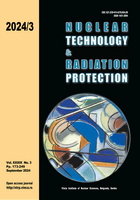
GAMMA-RAY ATTENUATION CHARACTERISTICS OF POLYPROPYLENE FILLED WITH NANO-SIZED AND BULK Bi2O3 AND CuO

Vol.
XXXIX, No. 3, Pp. 173-249
September 2024
UDC 621.039+614.876:504.06
ISSN 1451-3994
Pages: 199-211
Authors: Mona M. Gouda, Mona Shelby, Khulud Habanjar, Amro Obeid, Ramadan Awad, and Mohamed S. BadawiAbstract
Polypropylene was produced using compression molding and combined with bulk Bi2O3/CuO, and Bi2O3/CuO nanocomposites at various filler weight fractions (0 %, 5 %, 10 %, 15 %, and 20 %). Gamma-ray energies from four radioactive sources (241Am, 133Ba, 137Cs, and 60Co), ranging from 59.53 keV to 1332.5 keV, were used to evaluate the radiation attenuation capabilities of the new PP/Bi2O3/CuO polymer composite. Parameters such as the mass attenuation coefficients, total molecular cross-section, effective atomic cross-section, total electronic cross-section, electron density, effective atomic number, half-value layer, tenth value layer, and relaxation length were examined. The results underscored the significant influence of both the size and weight fraction of Bi2O3/CuO fillers on the gamma-ray shielding ability of the polypropylene composite, particularly at lower gamma-ray energy levels. Pure lead, a traditional and widely used shielding material, was used as a reference to assess the effectiveness of the polypropylene composite's half-value layer. Polypropylene composites incorporating nano-sized Bi2O3/CuO exhibited notable improvements in attenuation parameters, highlighting their potential for radiation protection and gamma-ray shielding applications.
Key words: polypropylene composite, Bi2O3/CuO nanocomposite, attenuation parameter, radiation protection
FULL PAPER IN PDF FORMAT (798 KB)